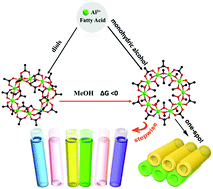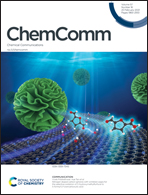Aluminium nanorings: configuration deformation and structural transformation†
Abstract
Present herein is the first example of aluminium nanoring assembly by fatty acids. And the auxiliary alcohol sites can be modified either by monohydric alcohols (AlOC-33 to AlOC-35) or diols (AlOC-36 to AlOC-38). The monohydric alcohol modified ten-membered aluminium (Al10) rings are coplanar, while the diol modified ones possess a saddle-shaped configuration. Interestingly, the diol modified Al10 ring (AlOC-36) can convert into a coplanar ring (AlOC-33-B). AlOC-33-B possesses a similar molecular structure but a different supramolecular structure with AlOC-33. The structural transformation is confirmed to be a thermodynamically spontaneous process through density-functional theory (DFT) calculations.



 Please wait while we load your content...
Please wait while we load your content...